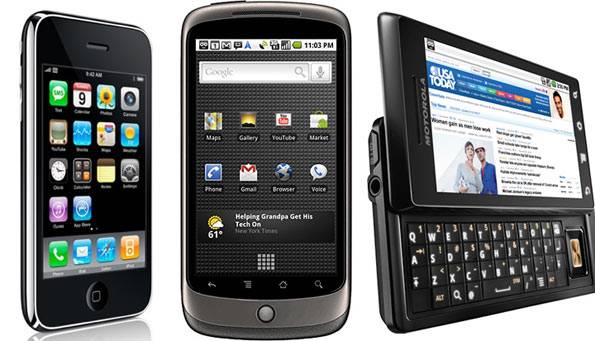
Its been a while since we have seen a formidable battle of the giants. Hence we decided to create one. As mouth watering as these phones can be, imagine what you will do if you are asked to choose one of them? Confused! Exactly this is what happened to us, and we decided to go for this analysis.
The most basic differentiation of these phones is their OS. The iPhone OS is very different from the Android 2.1 (recently upgraded in the Droid), while the earlier has features like the iTunes, we believe it is the latter that has an edge over the other with the ability to multi-task. So one thing gets clear, you got to lose some, to get some. Here, is a look at the spec sheet:
| Feature | iPhone 3GS | Droid / Milestone | Nexus One |
| Network | 2G Network GSM 850 / 900 / 1800 / 1900 3G HSDPA 850 / 1900 / 2100 HSDPA 7.2 Mbp |
WCDMA/900/2100, GSM 850/900/1800/1900 HSPA, GPRS Class 12, |
UMTS Band 1/4/8 (2100/AWS/900) GSM/EDGE (850, 900, 1800, 1900 MHz) HSDPA 7.2Mbps |
| OS | iPhone OS 3.0 | Android OS 2.1 | Android OS 2.1 |
| Display | TFT capacitive touch 16M colors 320 x 480 pixels, 3.5 inches |
3.7″ Capacitive touch 854×480 (16:9 widescreen) |
3.7-inch (touchscreen) widescreen WVGA AMOLED |
| Camera | 3.15 MP / Autofocus |
30 fps Video recording with audio5MP, Autofocus
LED Flash
Video 30 fps
with audio5 MPAutofocus
2X digital zoom
LED flashInternet BrowserMobile Safari
Full HTML
without FlashLocation enabled,
multi window
HTML5 webkitLocation enabled,
multi window
HTML5 webkitMessagingSMS (threaded view),
MMS, EmailsSMS, MMS, EmailSMS, MMS, EmailProcessor600 MHz CPU550 Mhz CPUQualcomm QSD 8250 1 GHzBatteryUnknown
Talktime 12 hrs 2G
5 hours on 3G1400 mAh Li-ion
GSM: up 350 hrs;
3G: 380 hrs standby.
No info on talktime1400 mAH battery
2G Talktime 10 hours
7 hours on 3G
standby:
290 hrs 2G
250 hrs 3GConnectivityBluetooth AD2P (headset only)
Bluetooth P2P games
WiFi, aGPSMicroUSB
Stereo Bluetooth 2.1
aGPS, WiFiWi-Fi (802.11b/g)
Bluetooth 2.1 + EDR
A2DP stereo BluetoothMemory256 MB RAM
16 GB/ 32 GB internal256 MB Ram
512 MB Rom
(MicrosSD card slot)512MB Flash
512MB RAM
4GB Micro SDHC CardWeight135 gms169 gms130 gramsOthers
- Digital compass
- Spotlight Search
- Light / Proximity sensor
- Landscape keyboard in all apps
- VoiceOver (Voice Controls)
- iTunes App Store
- Shake to change music
- 3.5 mm audio jack
- Accelerometer sensor
- Light / Proximity sensor
- Android Market
- Multitasking
- Physical QWERTY (slideout)
- Search SMS / MMS
- 3.5mm audio connecto
- Assisted global positioning system (AGPS) receiver
- Cell tower and Wi-Fi positioning
- Digital compass
- Accelerometer
EDGEHSDPA supported 7.2 MbpsHSDPA 7.2MbpsHSDPA 7.2MbpsFMNoNoNoColoursWhite and BlackBrownGrey
The basic decision making is on the form factor. If you cannot live without the physical qwerty, the Droid wins hands on. However if, you are willing to learn the onscreen keyboard (which is amazing in the iPhone), you have a tough choice to make. So what are the OS advantages?
iPhone OS:
- 140k apps on the Appstore
- no flash, but still the best web browser
- Spotlight search
- Multitouch keyboard – best onscreen typing
Android OS:
- An open OS: you wont miss Bluetooth file trf or USB mass storage
- Open Source – means more customization, no jailbreaking
- Google Navigation is FREE
The choice is simple – if you can’t live without the App Store – iPhone it is for you. Else the Android OS comes into the pictures. Amongst other things both Motorola Droid and the Google Nexus One have a bigger screen & a better camera than the iPhone (along with LED Flash, which the iPhone missed out on). Also, the processor on the Nexus one is 1GHz Snapdragon – the best for smartphones. So what are you buying, we would love to hear from you in comments below…
